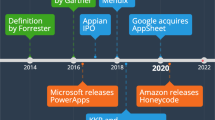Zusammenfassung
Low-Code-Development als Softwareparadigma ist ein vergleichsweise neuer Ansatz, der erstmals 2014 unter diesem Begriff Erwähnung fand. Die Konzepte, welche dem Ansatz zugrunde liegen, wurden jedoch in weiten Teilen schon in anderen Erscheinungsformen der Softwareentwicklung genutzt, die schon eine zum Teil deutlich längere Historie aufweisen. In diesem Kapitel werden mit den Programmiersprachen der 4. Generation (4GL), der generativen und modellgetriebenen Softwareentwicklung, dem Rapid Application Develepment, End-User-Development sowie dem Domain-Driven Design verschiedene Softwareentwicklungsansätze vorgestellt, welche als Vorläufer der Low-Code-Programmierung angesehen werden können. Zu jedem der Ansätze werden einige bekannte Beispiel-Werkzeuge genannt sowie Gemeinsamkeiten und Unterschiede der jeweiligen Ansätze im Vergleich zur Low-Code-Programmierung herausgearbeitet. Abschließend werden die Begriffe „Low Code“, „No Code“ und „High Code“ voneinander abgegrenzt, sodass am Ende dieses Kapitels eine Definition für Low-Code-Development vorliegt, welche für den weiteren Verlauf dieses Buchs gültig ist.
Access this chapter
Tax calculation will be finalised at checkout
Purchases are for personal use only
Similar content being viewed by others
Literatur
Balzert H, Hofmann F, Kruschinski V, Niemann C (1996) The JANUS Application Development Environment—Generating More than the User Interface. In: CADUI 1996, S 183–208.
Boehm BW (1988) A Spiral Model of Software Development and Enhancement. Computer 21(5):61–72. https://doi.org/10.1109/2.59.
Costabile MF, Fogli D, Mussio P, Piccinno A (2007) Visual Interactive Systems for End-User Development: A Model-Based Design Methodology. IEEE Transactions on Systems, Man, and Cybernetics – Part A: Systems and Humans 37(6):1029–1046. https://doi.org/10.1109/TSMCA.2007.904776.
Evans E (2003) Domain-Driven Design. Tackling Complexity in the Heart of Software. Addison-Wesley.
Martin J (1982) Application Development without Programmers. Prentice Hall Englewood Cliffs, N.J.
Martin J (1985) Fourth-Generation Languages. Prentice Hall Englewood Cliffs, N.J.
Marzullo FP, de Souza JM, Blaschek JR (2008) A Domain-Driven Development Approach for Enterprise Applications, Using MDA, SOA and Web Services. In: CEC/EEE 2008, S 432–437. https://doi.org/10.1109/CECandEEE.
Stevens P (2010) Bidirectional Model Transformations in QVT: Semantic Issues and Open Questions. Softw. Syst. Model. 9(1):7–20. https://doi.org/10.1007/s10270-008-0109-9.
Voelter M, Lisson S (2014) Supporting Diverse Notations in MPS’ Projectional Editor. In: GEMOC@MoDELS 2014, S 7–16.
Author information
Authors and Affiliations
Corresponding author
Editor information
Editors and Affiliations
Rights and permissions
Copyright information
© 2023 Der/die Autor(en), exklusiv lizenziert an Springer-Verlag GmbH, DE, ein Teil von Springer Nature
About this chapter
Cite this chapter
Sauer, S., Weidmann, N., Kirchhoff, J. (2023). Merkmale und Entwicklungslinien der Low-Code-Programmierung. In: Hinrichsen, S., Sauer, S., Schröder, K. (eds) Prozesse in Industriebetrieben mittels Low-Code-Software digitalisieren . Intelligente Technische Systeme – Lösungen aus dem Spitzencluster it’s OWL. Springer Vieweg, Berlin, Heidelberg. https://doi.org/10.1007/978-3-662-67950-0_2
Download citation
DOI: https://doi.org/10.1007/978-3-662-67950-0_2
Published:
Publisher Name: Springer Vieweg, Berlin, Heidelberg
Print ISBN: 978-3-662-67949-4
Online ISBN: 978-3-662-67950-0
eBook Packages: Computer Science and Engineering (German Language)




